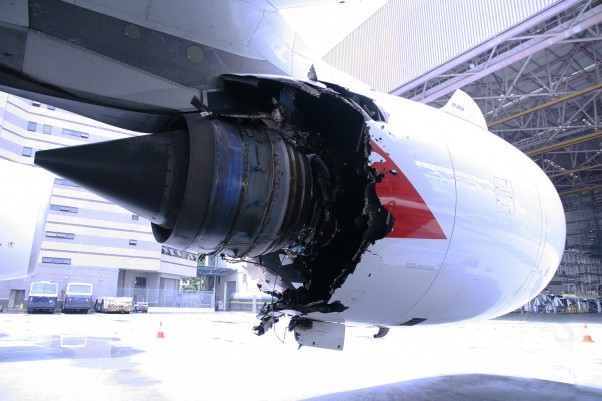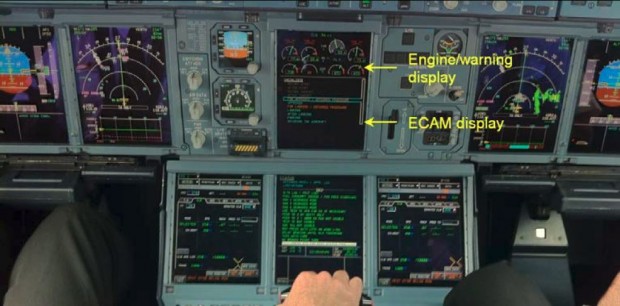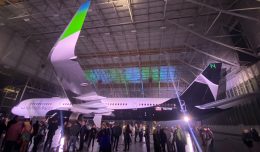The Australian Transport Safety Bureau on Thursday released their final report into the Qantas A380 uncontained engine failure over Indonesia on November 4, 2010. The 305 page report gives a full account of the major incident, with images from inside the aircraft still in-flight, as well as a very detailed analysis of the cause. With 440 passengers and 24 cabin crew on board, the number 2 engine (A Rolls-Royce Trent 900) sustained an uncontained failure, leading to a dramatic chain of events which eventually saw the aircraft land safely back at its origin of Changi Airport in Singapore.
The engine failure was determined to be caused by the release of oil from a crack in the pipe that supplied oil to the high pressure/intermediate pressure (HP/IP) turbine bearing chamber. The ATSB determined that the oil pipe cracked because it had a thin wall from a misaligned counter bore that did not conform to the design specification.
The following are excerpts from the ATSB “sequence of events” summary:
At about 02:01, while maintaining 250 kt in the climb and passing 7,000 ft above mean sea level (AMSL), the crew heard two, almost coincident ‘loud bangs’.
The crew reported that there was a slight yaw and the aircraft levelled off in accordance with the selection of altitude hold. The captain stated that he expected the aircraft’s autothrust system to reduce thrust on the engines to maintain 250 kt as the aircraft levelled off. However, the autothrust system was no longer active, so he manually retarded the thrust levers to control the aircraft’s speed.
A damage assessment as part of the engine failure procedure suggested that the damage to the No. 2 engine was serious and the flight crew discharged one of the engine’s two fire extinguisher bottles. Contrary to their expectation, the flight crew did not receive confirmation that the fire extinguisher bottle had discharged. They repeated the procedure for discharging the fire extinguisher and again did not receive confirmation that it had discharged.
As the second officer moved through the cabin, a passenger, who was also a pilot for the operator, brought his attention to a view of the aircraft from the vertical fin-mounted camera that was displayed on the aircraft’s in-flight entertainment system. That display showed a fuel leak from the left wing.
The flight crew reported that, during their assessment of subsequent multiple fuel system ECAM messages, they elected not to initiate further fuel transfer as they were unsure of the integrity of the fuel system.
The inoperative wing leading edge lift devices, reduced braking function, reduced number of operational spoilers and inactive left engine thrust reverser8 resulted in an abnormal landing configuration, which in turn affected the landing distance calculation. After some initial difficulty in calculating the landing distance required due to the high number of system and flight control malfunctions, the flight crew determined that a landing within the distance available on runway 20C at Changi Airport was achievable and proceeded on that basis.
Following the engine failure and subsequent system damage, the autopilot remained operational. The captain, as the handling pilot, continued to fly the aircraft using the autopilot during the time that the crew managed the ECAM procedures.
The No. 3 engine was gradually moved out of maximum reverse thrust and manual braking was continued until the aircraft came to a stop about 150 m from the end of the runway.
After some initial confusion about which radio was functioning, the first officer contacted the emergency services fire commander, who asked for the No. 1 engine to be shut down. The first officer responded that they had done so already, but was advised again by the fire commander that the engine continued to run.The flight crew briefly discussed the still-running No. 1 engine and recycled the engine master switch to OFF, but the engine did not shut down. In response, the flight crew decided to press the engine fire push button and then fire extinguisher bottles in an attempt to shut down the engine. This was also ineffective and the engine continued to run.
Finally, the decision was taken by the operator to ‘drown’ the engine, initially with water and then with fire fighting foam from the airport emergency services fire vehicles (Figure 4). The No. 1 engine was reported to have been shut down at 06:53:00, about 3 hours after the aircraft landed.
Although faced with numerous system failures, failed and degraded engines, and damage to extremely critical components such as a wing spar and ribs, the flight crew kept cool and landed the aircraft safely. After over a year of repairs, VH-OQA returned to the skies, and is still in service with Qantas today.
The full ATSB report is available on their website, and we highly recommend you flip through it over a large cup of coffee.









